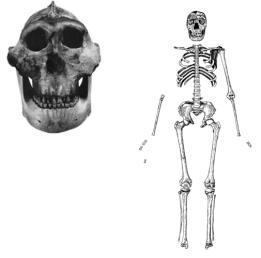The Paranthropines were a bizarre offshoot of the human family that lived from 2.7 – 1.3 million years ago. They were our cousins, who lived alongside Australopithecus (like Lucy and Au. sediba) and later our own genus, Homo. Although part of our family they looked nothing like us, with huge jaws and an odd-looking cranium, distorted by evolution to accommodate their huge chewing muscles.

The skull of P. boisei (right) and the contemporary, more human-like Homo erectus (left)
Recently dated teeth show Paranthropus boisei was alive in Africa just 1.33 million years ago; making them the youngest Paranthropines. They lived alongside Homo erectus – the species that would eventually become us – who was looking very modern by this point. They had a large brain, was creating beautiful stone tools and was a tool, upright biped. They were even beginning to spread out of Africa and round the world. Meanwhile what was P. boisei doing? Well we don’t really know, given that we’ve found very little of their skeleton. Some very pretty (well what passes for pretty amongst gorilla-men) and complete skulls yes; but not much else. A handful of shattered legbones and pieces of foot, but nothing that substantial.

KNM-ER 1500. Prior to this the most complete P. boisei skeleton found
Fortunately these teeth – details of which were only published in December of last year – were associated with an in situ (that is, undisturbed) skeleton; which consisted of a partial humerus, radius, femur and tibia, all of which appear to have been gnawed on by scavengers. It might not sound like much, but when KNM-ER 1500 (that picture on the right) is the best we’ve got; it is a huge improvement. But what can it tell us about P. boisei?
Well the first notable thing about this skeleton – known as OH-80 – is the sheer size of the beast. This individual stood 1.5 m tall and weighed between 40 – 60 kg. That puts them about on par with Homo erectus, who typically stood between 1.4 – 1.8 meters tall and weighed 40 – 68 kg (there will be no imperial conversions for the yanks; on general principle). What leaps out here is that whilst OH-80 is ~20% smaller than the tallest Homo erectus, they’re only 10% lighter than the heaviest. In other words they were a lot more heavily built.
Which is the second most notable thing about the skeleton: it’s very robust. The bones are thick and strong, again supporting the idea they were very heavily built. Their arms in particular appear to be much longer and stronger than what contemporary humans had. In fact, their radius and humerus are actually the largest and strongest of any member of the human family yet discovered; and show remarkable similarities to orang-utans (who spend a lot of their time climbing trees). Perhaps this indicates that, bulky as they were, Paranthropus boisei was an adept climber that spent a lot of time in trees.
The other interesting thing is that they’re not only big compared to Homo erectus, they’re big compared to the other P. boisei skeletons we’ve found. Granted, the KNM-ER 1500 fossil is in tiny tiny pieces, but it still seems to have been much smaller than this new discovery. This seems to suggest that there was a fair bit of sexual dimorphism amongst the species, with the males being much larger than the females. Again, this stands in stark contrast to Homo erectus; which was only the most sexually equal species of human (size wise I mean, I suspect there was not a strong suffragette movement in the Pleistocene).

The arm and leg bones of OH-80
In short, they’re much bigger and stronger than anyone anticipated (although the sexual dimorphism was expected); and would’ve been as tall as any contemporary humans. Even compared to us moderns they wouldn’t seem unusually short. Despite that they were still adept climbers, apparently behaving a lot like apes. tl;dr: these weird looking human cows have taken an even weirder turn.
References
Domínguez-Rodrigo M, Pickering TR, Baquedano E, Mabulla A, Mark DF, et al. (2013) First Partial Skeleton of a 1.34-Million-Year-Old Paranthropus boisei from Bed II, Olduvai Gorge, Tanzania. PLoS ONE 8(12): e80347. doi:10.1371/journal.pone.0080347
Wood, B., & Constantino, P. (2007). Paranthropus boisei: fifty years of evidence and analysis. American journal of physical anthropology, 134(S45), 106-132.

